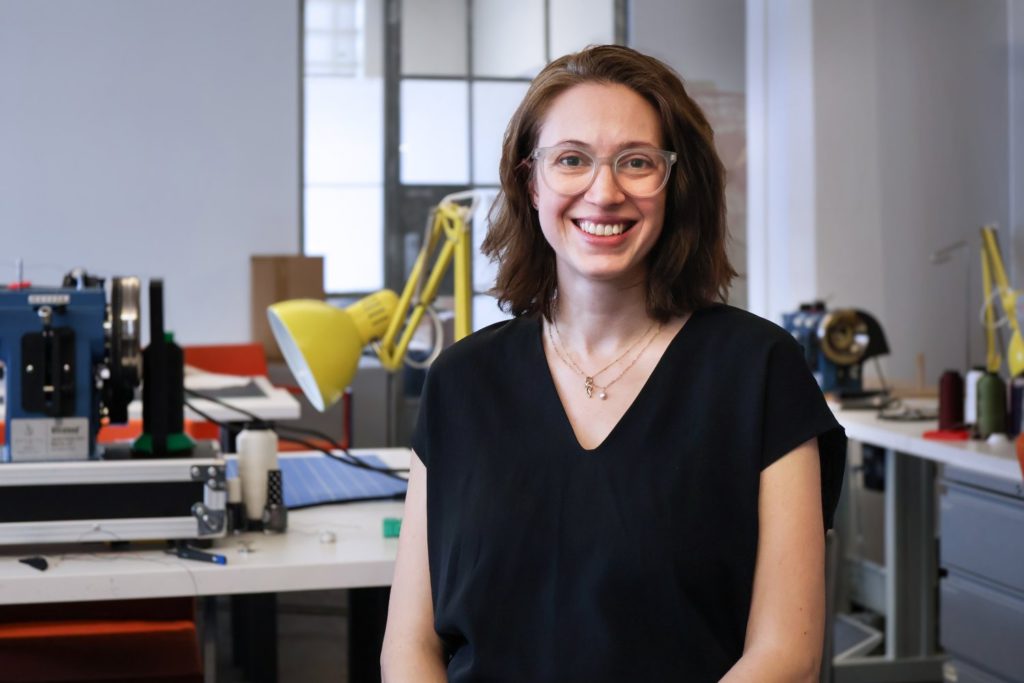MIT Morningside Academy for Design (MAD) Fellow Caitlin Morris is an architect, artist, researcher, and educator who has studied psychology and used online learning tools to teach herself coding and other skills. She’s a soft-spoken observer, with a keen interest in how people use space and respond to their environments. Combining her observational skills with active community engagement, she works at the intersection of technology, education, and human connection to improve digital learning platforms.
Morris grew up in rural upstate New York in a family of makers. She learned to sew, cook, and build things with wood at a young age. One of her earlier memories is of a small handsaw she made — with the help of her father, a professional carpenter. It had wooden handles on both sides to make sawing easier for her.
Later, when she needed to learn something, she’d turn to project-based communities, rather than books. She taught herself to code late at night, taking advantage of community-oriented platforms where people answer questions and post sketches, allowing her to see the code behind the objects people made.
“For me, that was this huge, wake-up moment of feeling like there was a path to expression that was not a traditional computer-science classroom,” she says. “I think that’s partly why I feel so passionate about what I’m doing now. That was the big transformation: having that community available in this really personal, project-based way.”
Subsequently, Morris has become involved in community-based learning in diverse ways: She’s a co-organizer of the MIT Media Lab’s Festival of Learning; she leads creative coding community meetups; and she’s been active in the open-source software community development.
“My years of organizing learning and making communities — both in person and online — have shown me firsthand how powerful social interaction can be for motivation and curiosity,” Morris said. “My research is really about identifying which elements of that social magic are most essential, so we can design digital environments that better support those dynamics.”
Even in her artwork, Morris sometimes works with a collective. She’s contributed to the creation of about 10 large art installations that combine movement, sound, imagery, lighting, and other technologies to immerse the visitor in an experience evoking some aspect of nature, such as flowing water, birds in flight, or crowd kinetics. These marvelous installations are commanding and calming at the same time, possibly because they focus the mind, eye, and sometimes the ear.
She did much of this work with New York-based Hypersonic, a company of artists and technologists specializing in large kinetic installations in public spaces. Before that, she earned a BS in psychology and a BS in architectural building sciences from Rensselaer Polytechnic Institute, then an MFA in design and technology from the Parsons School of Design at The New School.
During, in between, after, and sometimes concurrently, she taught design, coding, and other technologies at the high school, undergraduate, and graduate-student levels.
“I think what kind of got me hooked on teaching was that the way I learned as a child was not the same as in the classroom,” Morris explains. “And I later saw this in many of my students. I got the feeling that the normal way of learning things was not working for them. And they thought it was their fault. They just didn’t really feel welcome within the traditional education model.”
Morris says that when she worked with those students, tossing aside tradition and instead saying — “You know, we’re just going to do this animation. Or we’re going to make this design or this website or these graphics, and we’re going to approach it in this totally different way” — she saw people “kind of unlock and be like, ‘Oh my gosh. I never thought I could do that.’
“For me, that was the hook, that’s the magic of it. Because I was coming from that experience of having to figure out those unlock mechanisms for myself, it was really exciting to be able to share them with other people, those unlock moments.”
For her doctoral work with the MIT Media Lab’s Fluid Interfaces Group, she’s focusing on the personal space and emotional gaps associated with learning, particularly online and AI-assisted learning. This research builds on her experience increasing human connection in both physical and virtual learning environments.
“I’m developing a framework that combines AI-driven behavioral analysis with human expert assessment to study social learning dynamics,” she says. “My research investigates how social interaction patterns influence curiosity development and intrinsic motivation in learning, with particular focus on understanding how these dynamics differ between real peers and AI-supported environments.”
The first step in her research is determining which elements of social interaction are not replaceable by an AI-based digital tutor. Following that assessment, her goal is to build a prototype platform for experiential learning.
“I’m creating tools that can simultaneously track observable behaviors — like physical actions, language cues, and interaction patterns — while capturing learners’ subjective experiences through reflection and interviews,” Morris explains. “This approach helps connect what people do with how they feel about their learning experience.
“I aim to make two primary contributions: first, analysis tools for studying social learning dynamics; and second, prototype tools that demonstrate practical approaches for supporting social curiosity in digital learning environments. These contributions could help bridge the gap between the efficiency of digital platforms and the rich social interaction that occurs in effective in-person learning.”
Her goals make Morris a perfect fit for the MIT MAD Fellowship. One statement in MAD’s mission is: “Breaking away from traditional education, we foster creativity, critical thinking, making, and collaboration, exploring a range of dynamic approaches to prepare students for complex, real-world challenges.”
Morris wants to help community organizations deal with the rapid AI-powered changes in education, once she finishes her doctorate in 2026. “What should we do with this ‘physical space versus virtual space’ divide?” she asks. That is the space currently captivating Morris’s thoughts.
Source: Read MoreÂ




